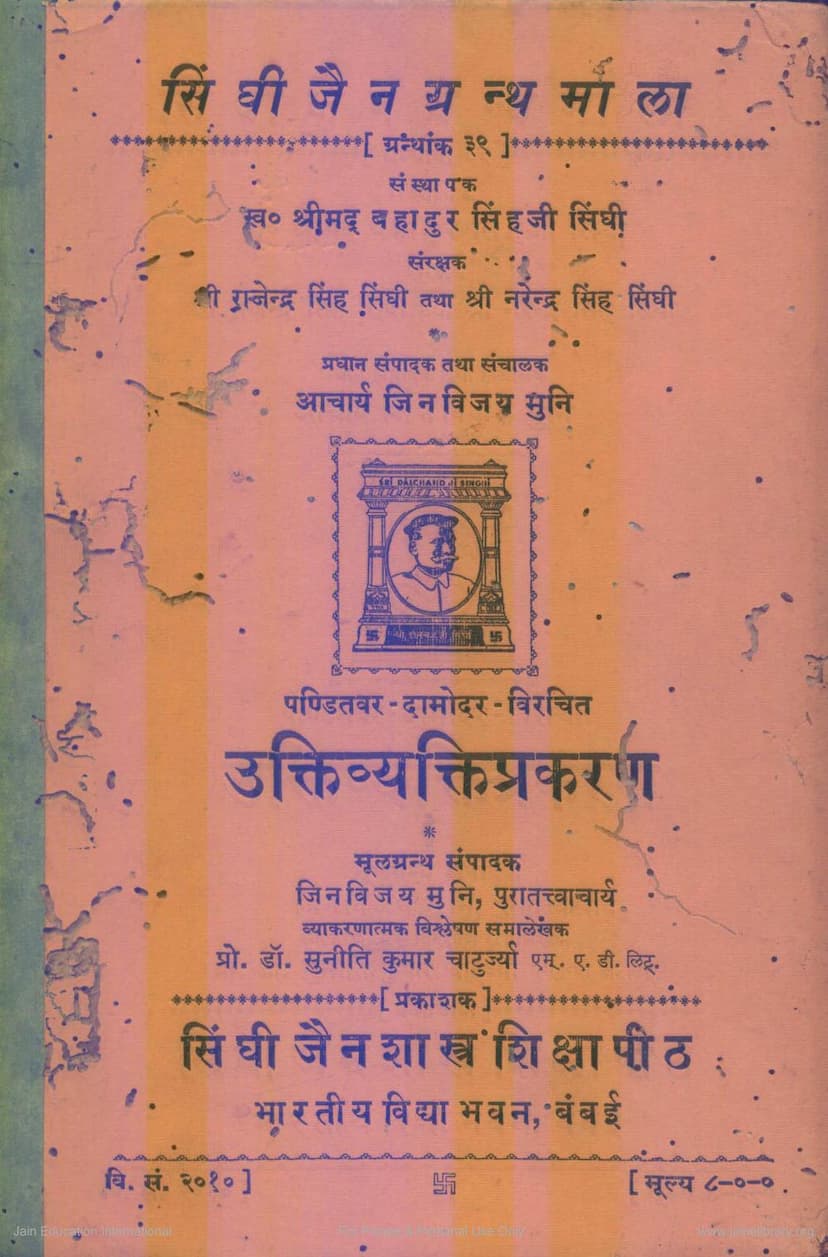Ukti Vyakti Prakarana
Added to library: September 2, 2025

Summary
The Ukti Vyakti Prakarana is a significant work attributed to Damodar Pandit, published by the Singhi Jain Shastra Shiksha Pith, Mumbai, as part of the Singhi Jain Granthamala series (Volume 39). This text is a foundational handbook for Sanskrit composition, notable for its inclusion of parallel illustrations in Old Kosali, dating back to the 12th century.
Key Aspects and Content:
- Author and Context: Damodar Pandit, a scholar of considerable repute, likely composed this work during the reign of King Govindachandra of the Gahadwala dynasty (c. 1114-1155 AD). The manuscript itself is a later copy, estimated to be from the late 13th century.
- Linguistic Significance: The text is primarily valued for its linguistic content. It provides an elementary guide to Sanskrit composition but is most critically important for its preservation of Old Kosali, an early form of Eastern Hindi (Awadhi). This makes it the earliest known specimen of this dialect, predating known literary works by centuries. Dr. Suniti Kumar Chatterji, a renowned linguist, provided an exhaustive linguistic study of the Old Kosali speech presented in the text.
- Content Structure: The Ukti Vyakti Prakarana is structured around the principles of Sanskrit composition, explaining the use of grammatical elements and their application in practical language. It covers:
- Kriyokti-vyakti (Chapter on Verb-Okti): This section details the nuances of verb usage, including tenses (present, past, future), moods, and the formation of verbal phrases. It analyzes the specific forms used in Old Kosali, often drawing parallels with Sanskrit grammar.
- Kārokti-vyakti (Chapter on Kāraka-Okti): This part focuses on the use of grammatical cases (kārakas) – nominative, accusative, instrumental, dative, ablative, genitive, and locative – in Old Kosali, explaining their functions and providing examples.
- Ukti-bheda (Chapter on Okti-variations): This section discusses the factors that contribute to variations in language usage (uktis), such as time (kala), gender (linga), number (sankhya), person (purusha), and the interplay between spoken and written forms. It outlines a complex system of calculating the possible variations in linguistic expression based on these factors.
- Lekha-likhana-vidhi (Chapter on Letter-writing Method): This practical section provides guidance on the proper format and conventions for writing letters, including elements like greetings, dates, and proper address.
- Vyavaharika-lekha-patra-likhana-krama (Chapter on Practical Document Writing): This concluding part of the Karika section offers further details on formal documents, contracts, and record-keeping, specifying the necessary participants (donor, recipient, witnesses, scribe) and essential components.
- Social and Historical Insights: Dr. Moti Chandra's essay on the material of social and historical interest within the text sheds light on the cultural milieu of 12th-century North India, particularly Banaras. It details aspects of:
- Patronage: The work was likely patronized by King Govindachandra, who was an orthodox Hindu and a supporter of Brahminical learning. Inscriptions confirm Damodar Sarman (likely the author) received significant land grants from the king and his sons, suggesting he was a respected teacher.
- Education: Banaras is highlighted as a major educational center, with a curriculum emphasizing religious literature. The text provides glimpses into student life, teacher-student relationships, and the prevalent methods of teaching, including the use of proverbs and dialogues. It also notes the Brahmin monopoly over Sanskrit learning at the time.
- Religious Practices: The text reflects the religious landscape, mentioning the importance of the Ganges, rituals, reverence for forefathers, and the prominent role of Brahmins in society and religious festivals. It touches upon concepts like expiation and the belief in supernatural entities.
- Social Customs: Insights are provided into daily life, housing, domestic chores, food habits (including vegetarian and non-vegetarian dishes), the social status of merchants, professions like oilmen, florists, barbers, hunters, and boatmen, and the prevalence of crime.
- Arts and Entertainment: The text mentions storytelling, wrestling, gymnastics, puppet shows, and the keeping of parrots as forms of amusement.
- Economic and Administrative Aspects: The role of merchants, bankers, currency (gadyanaka, cowries), the organization of precious articles under 'bhandari', and principles of property division are also touched upon.
Publication and Significance:
The Ukti Vyakti Prakarana was meticulously edited by Acharya Jina Vijaya Muni, with a grammatical analysis provided by Prof. Dr. Suniti Kumar Chatterji and an essay on social and historical aspects by Dr. Moti Chandra. Its publication was made possible through the munificence of the Singhi family, particularly in memory of Sri Bahadur Singhji Singhi, a noted patron of Jain literature and scholarship.
The work is considered invaluable for the study of New Indo-Aryan linguistics, particularly the historical development of the Kosali dialect. It stands alongside other significant regional linguistic documents like the Caryāpadas (Bengal), Varṇa-ratnākara (Mithila), and Jñāneśvari (Maharashtra) in its contribution to understanding the evolution of Indian languages and culture.